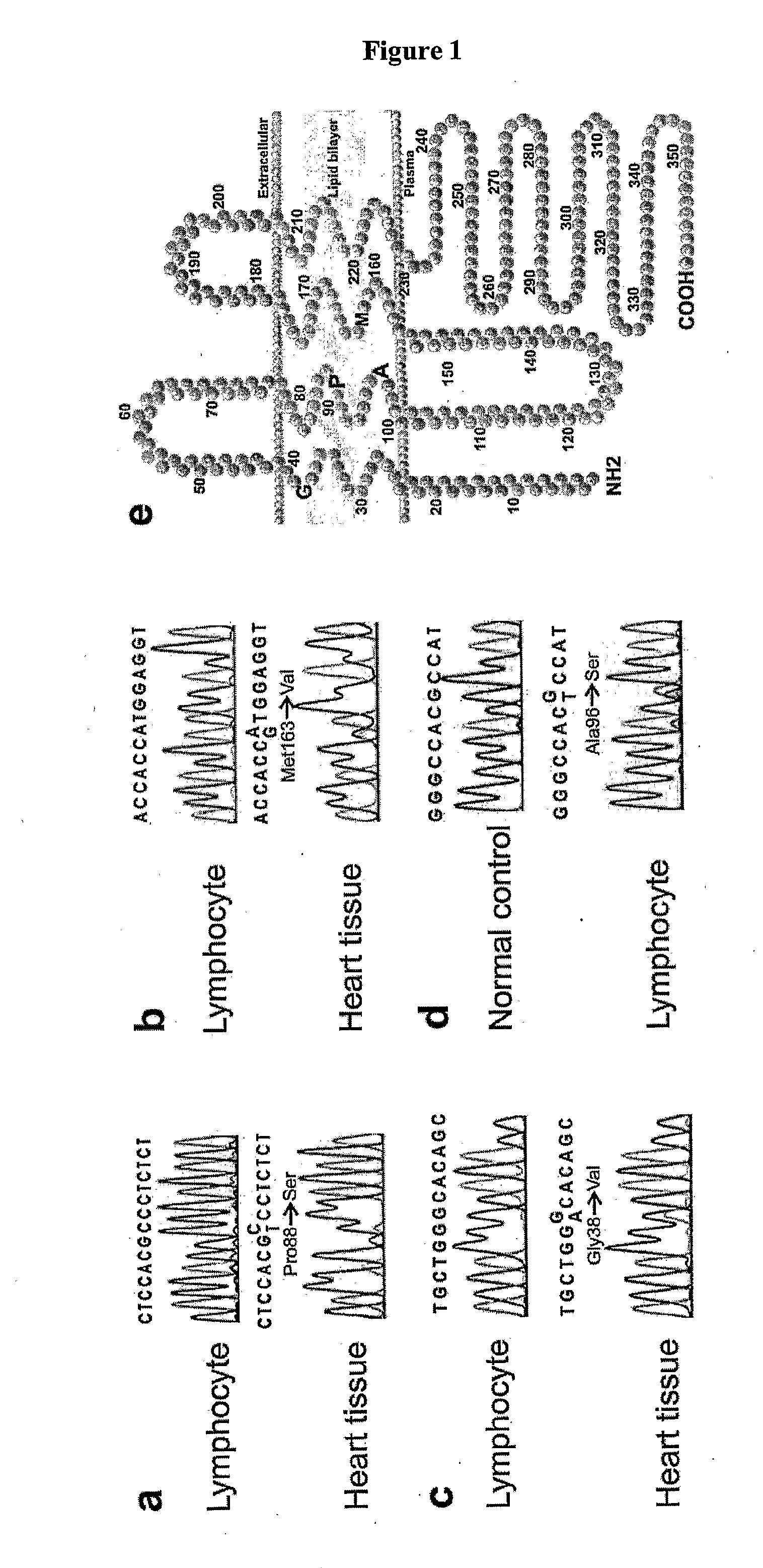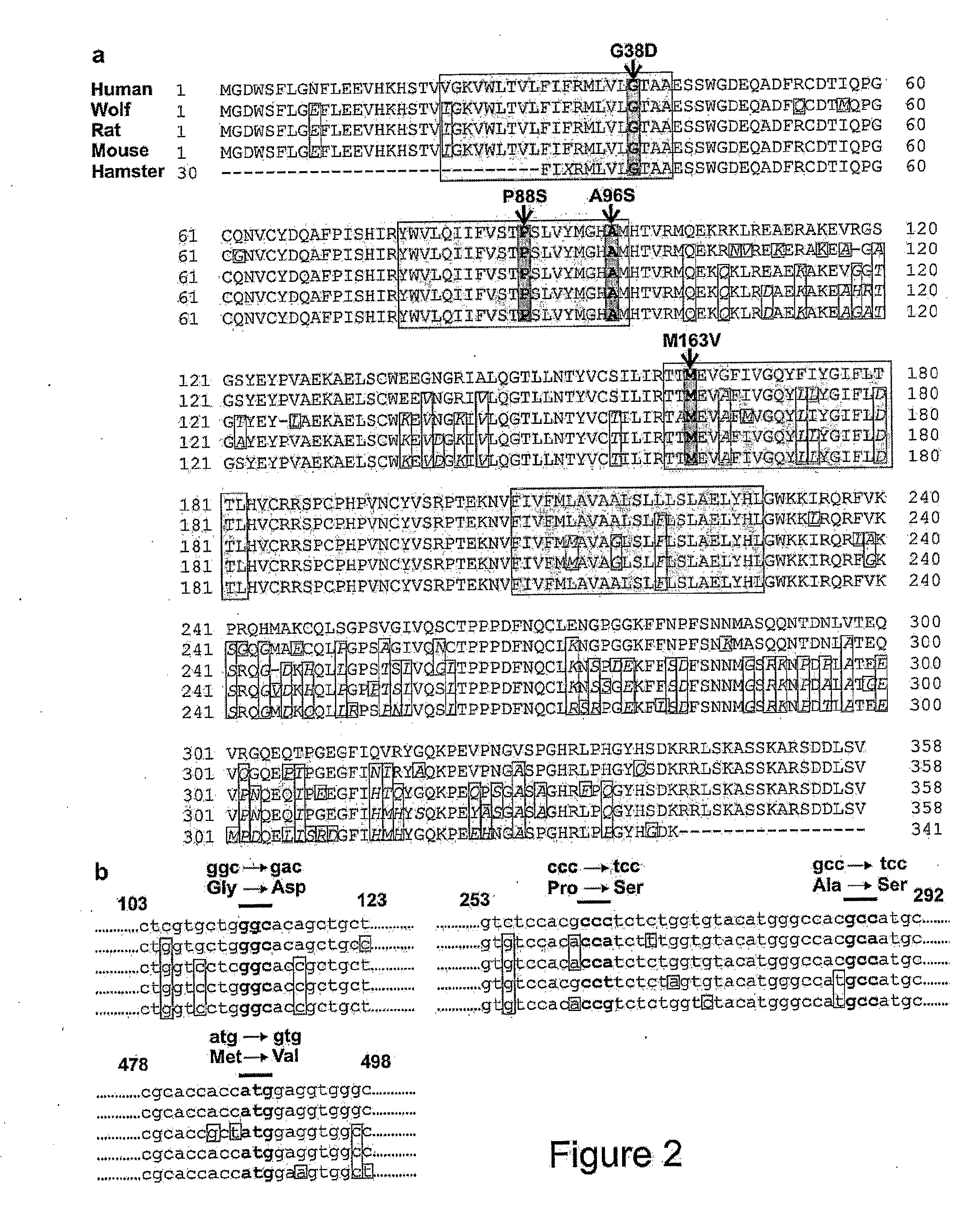Connexin 40 tissue specific gene mutations
a tissue specific gene and gene mutation technology, applied in the field of cardiac arrhythmia detection and treatment, can solve the problems of promoting clot formation, significant risk of stroke, and loss of effective atrial contractility
- Summary
- Abstract
- Description
- Claims
- Application Information
AI Technical Summary
Benefits of technology
Problems solved by technology
Method used
Image
Examples
example 1
Genomic DNA Analysis
[0103]Genomic DNA was isolated from resected cardiac tissue from 15 “idiopathic” atrial fibrillation (AF) patients who had undergone surgery for disease management10. All patients developed AF at age<55 years (range 33-54), and were refractory to multiple medications.
Genomic DNA Extraction
[0104]Genomic DNA from cardiac tissue was extracted from formalin-fixed, paraffin-embedded tissue sections. Tissue was de-paraffinized in xylene, followed by a 98% ethanol wash. Samples were dried and resuspended in 2× proteinase K digestion buffer with 250 μg / ml of proteinase K and incubated for 3 days at 55° C. DNA was then isolated using a phenol-chloroform extraction and re-suspended in sterile water. A second set of tissue sections had genomic DNA extracted using the DNAeasy Extraction Kit (Qiagen) for use in independent PCR reactions. Extraction of genomic DNA from peripheral blood lymphocytes was performed using the phenol-chloroform method in affected patients or the Fle...
example 2
Expression of Modified Cx40 in Neuroblastoma Cells
[0115]To determine the functional significance of Cx40 mutations, wild-type (wt) or mutant Cx40 proteins were expressed in a gap junctional communication-deficient cell line, neuroblastoma (N2A) cells, as described below.
Expression of Cx40Constructs and Expression in N2A Cells
[0116]Human wtCx40 coding sequence was amplified from commercially available genomic DNA (BD Biosciences). The PCR products were cloned into the TOPO 2.1 vector (Invitrogen). Using the wtCx40 clone as a template, Gly38Asp, Pro88Ser, Ala96Ser, and Met 163Val mutations were introduced by site-directed mutagenesis using the QuickChange mutagenesis kit (Stratagene). Clones were sequenced completely to confirm the mutation and exclude any other sequence variants that may have been introduced during PCR amplification.
[0117]For expression studies, wt and Cx40 mutants were subcloned into the pcDNA3.1(−) vector (Invitrogen). In order to engineer GFP-tagged wtCx40 and the...
example 3
Electrophysiologic Studies of Paired Cells
[0124]Intercellular electrical coupling properties of wt, and mutant Cx40 proteins was passed using paired N2A cells demonstrating visible gap junction plaques as obtained using the methods described in Example 2.
Electrophysiological Recordings
[0125]A coverslip with low density N2A cells was placed in a recording chamber and perfused with a solution containing (in mM): NaCl 140, KCI 5, CsCl 2, CaCl2 2, MgCl2 1, Hepes 5, D-glucose 5, pyruvate 2, and BaCl2 1, at pH=7.4. N2A cells were visualized via an inverted phase-contrast microscope (Leica DMIRB). GFP positive cell pairs were identified and selected for dual, whole cell, voltage-clamp recording (Axopatch 200B, Axon Instruments Inc.). To facilitate functional testing, cell pairs with visible plaques at the cell-cell junction were selected. Recordings were carried out at room temperature. The recording pipette had a resistance of 3-5 M when filled with an internal solution containing (in mM)...
PUM
| Property | Measurement | Unit |
|---|---|---|
| Electrical conductance | aaaaa | aaaaa |
| Electrical conductance | aaaaa | aaaaa |
| Electrical conductance | aaaaa | aaaaa |
Abstract
Description
Claims
Application Information
 Login to view more
Login to view more - R&D Engineer
- R&D Manager
- IP Professional
- Industry Leading Data Capabilities
- Powerful AI technology
- Patent DNA Extraction
Browse by: Latest US Patents, China's latest patents, Technical Efficacy Thesaurus, Application Domain, Technology Topic.
© 2024 PatSnap. All rights reserved.Legal|Privacy policy|Modern Slavery Act Transparency Statement|Sitemap



